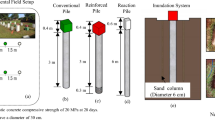Abstract
The geological, climatic and environmental conditions have resulted in the formation of calcareous deposits along the Arabian Gulf coast. Anhydrous calcium sulphate, which commonly occurs in such soils, is notorious for gypsification and dissolution and adds to the potential hazards of indigenous sediments. This paper discusses the properties of the sediments and the compressibility of the calcareous soil formations of eastern Saudi Arabia.
Résumé
Les conditions géologiques, climatiques et environnementales ont conduit à la formation de dépôts carbonatés le long de la côte du golfe Arabique. L'anhydrite, qui est présente communément dans de tels sols, est connue pour son aptitude à se transformer en gypse et subir les phénomènes de dissolution. Ce minéral aggrave les risques potentiels liés à ce type de sédiment. L'article présente les propriétés de ces sédiments et la compressibilité des sols carbonatés de l'est de l'Arabie Saoudite.
Similar content being viewed by others
Author information
Authors and Affiliations
Additional information
Received: 24 June 1999 · Accepted: 26 November 1999
Rights and permissions
About this article
Cite this article
Azam, S. Collapse and compressibility behaviour of arid calcareous soil formations. Bull Eng Geol Env 59, 211–217 (2000). https://doi.org/10.1007/s100640000060
Issue Date:
DOI: https://doi.org/10.1007/s100640000060




